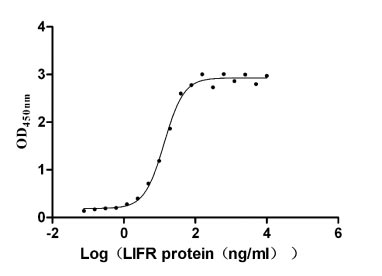Recombinant Rat Lipoma HMGIC fusion partner-like protein 4 (Lhfpl4), partial
-
中文名称:大鼠Lhfpl4重组蛋白
-
货号:CSB-YP759742RA1
-
规格:
-
来源:Yeast
-
其他:
-
中文名称:大鼠Lhfpl4重组蛋白
-
货号:CSB-EP759742RA1
-
规格:
-
来源:E.coli
-
其他:
-
中文名称:大鼠Lhfpl4重组蛋白
-
货号:CSB-EP759742RA1-B
-
规格:
-
来源:E.coli
-
共轭:Avi-tag Biotinylated
E. coli biotin ligase (BirA) is highly specific in covalently attaching biotin to the 15 amino acid AviTag peptide. This recombinant protein was biotinylated in vivo by AviTag-BirA technology, which method is BriA catalyzes amide linkage between the biotin and the specific lysine of the AviTag.
-
其他:
-
中文名称:大鼠Lhfpl4重组蛋白
-
货号:CSB-BP759742RA1
-
规格:
-
来源:Baculovirus
-
其他:
-
中文名称:大鼠Lhfpl4重组蛋白
-
货号:CSB-MP759742RA1
-
规格:
-
来源:Mammalian cell
-
其他:
产品详情
-
纯度:>85% (SDS-PAGE)
-
基因名:Lhfpl4
-
Uniprot No.:
-
别名:Lhfpl4; LHFPL tetraspan subfamily member 4 protein; Lipoma HMGIC fusion partner-like 4 protein
-
种属:Rattus norvegicus (Rat)
-
蛋白长度:Partial
-
蛋白标签:Tag type will be determined during the manufacturing process.
The tag type will be determined during production process. If you have specified tag type, please tell us and we will develop the specified tag preferentially. -
产品提供形式:Lyophilized powder
Note: We will preferentially ship the format that we have in stock, however, if you have any special requirement for the format, please remark your requirement when placing the order, we will prepare according to your demand. -
复溶:We recommend that this vial be briefly centrifuged prior to opening to bring the contents to the bottom. Please reconstitute protein in deionized sterile water to a concentration of 0.1-1.0 mg/mL.We recommend to add 5-50% of glycerol (final concentration) and aliquot for long-term storage at -20℃/-80℃. Our default final concentration of glycerol is 50%. Customers could use it as reference.
-
储存条件:Store at -20°C/-80°C upon receipt, aliquoting is necessary for mutiple use. Avoid repeated freeze-thaw cycles.
-
保质期:The shelf life is related to many factors, storage state, buffer ingredients, storage temperature and the stability of the protein itself.
Generally, the shelf life of liquid form is 6 months at -20°C/-80°C. The shelf life of lyophilized form is 12 months at -20°C/-80°C. -
货期:Delivery time may differ from different purchasing way or location, please kindly consult your local distributors for specific delivery time.Note: All of our proteins are default shipped with normal blue ice packs, if you request to ship with dry ice, please communicate with us in advance and extra fees will be charged.
-
注意事项:Repeated freezing and thawing is not recommended. Store working aliquots at 4°C for up to one week.
-
Datasheet :Please contact us to get it.
相关产品
靶点详情
-
功能:Plays a role in the regulation of inhibitory synapse formation and function by being involved in maintening gamma-aminobutyric acid receptors (GABAARs) clustering and their associated scaffold proteins at inhibitory synaptic sites. Acts in concert with NLGN2 to recruit or stabilize GABAARs.
-
基因功能参考文献:
- The results establish LHFPL4 as a synapse-specific tetraspanin essential for inhibitory synapse function and provide fresh insights into the molecular make-up of inhibitory synapses. PMID: 28978485
-
亚细胞定位:Cell projection, dendrite. Cell junction, synapse, postsynaptic cell membrane; Multi-pass membrane protein.
-
蛋白家族:LHFP family
-
数据库链接:
KEGG: rno:353230
STRING: 10116.ENSRNOP00000010347
UniGene: Rn.145133
Most popular with customers
-
Recombinant Human Leukemia inhibitory factor receptor (LIFR), partial (Active)
Express system: Mammalian cell
Species: Homo sapiens (Human)
-
Recombinant Rabbit Tissue factor pathway inhibitor (TFPI) (Active)
Express system: Mammalian cell
Species: Oryctolagus cuniculus (Rabbit)
-
Recombinant Human Transferrin receptor protein 1 (TFRC), partial (Active)
Express system: Mammalian cell
Species: Homo sapiens (Human)
-
Recombinant Macaca fascicularis C-type lectin domain family 4 member C(CLEC4C), partial (Active)
Express system: Mammalian cell
Species: Macaca fascicularis (Crab-eating macaque) (Cynomolgus monkey)
-
Express system: Mammalian cell
Species: Homo sapiens (Human)

















